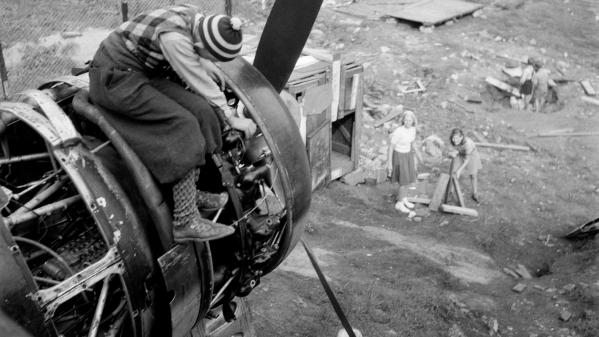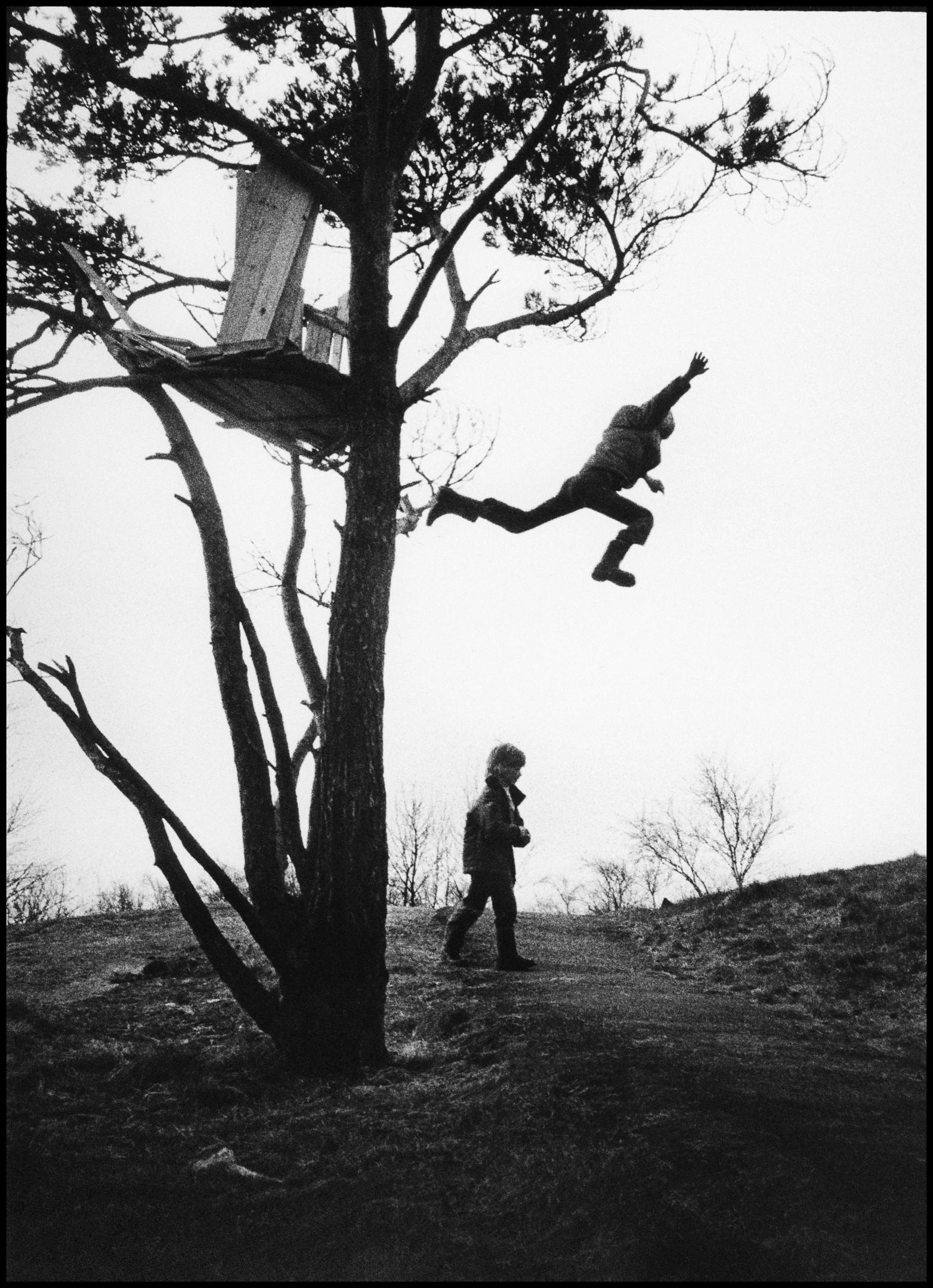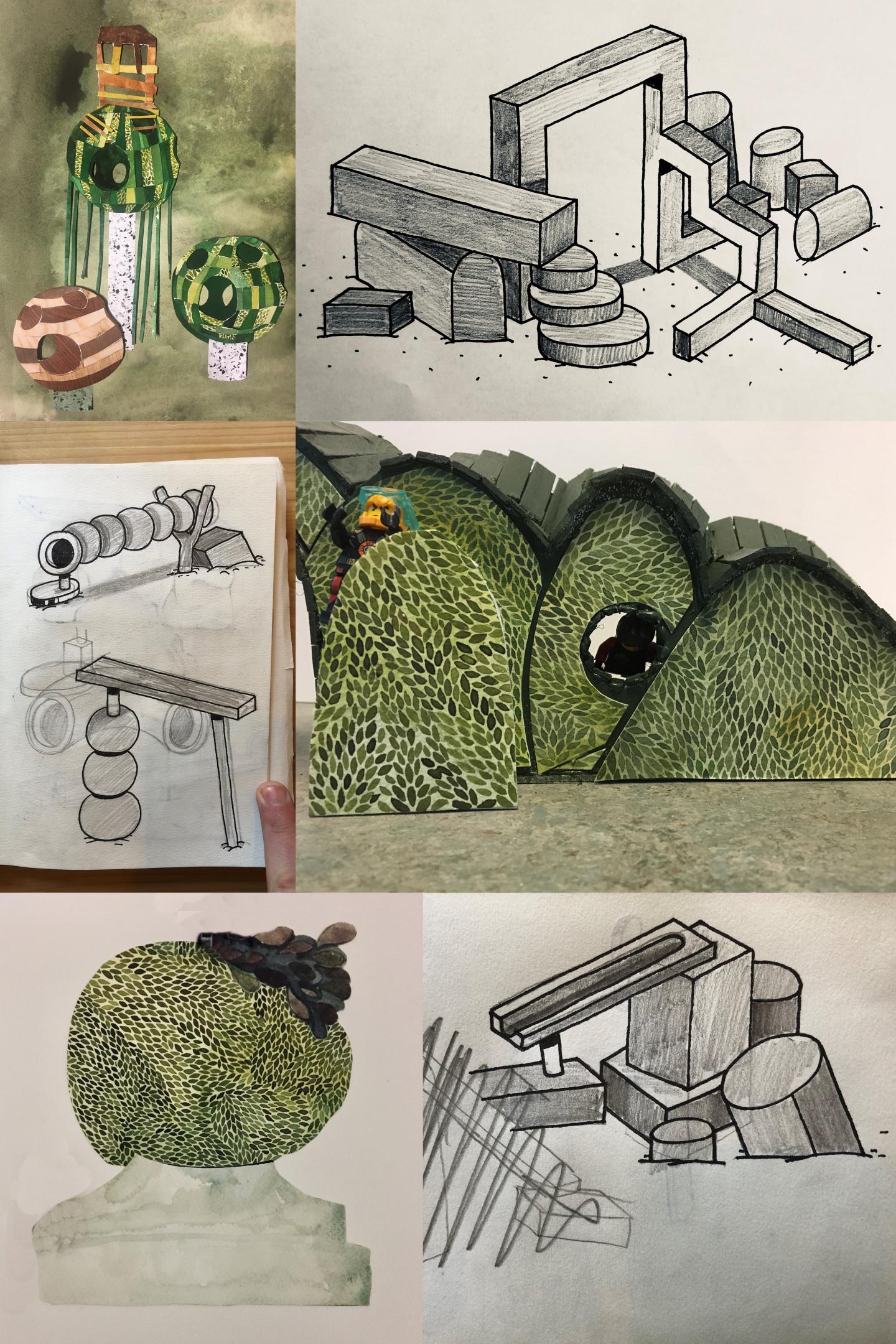City play past and present

Adventure playgrounds
The Danish landscape architect C. Th. Sørensen (1893–1979) saw that children who played outdoors liked messy environments best. Such playgrounds were missing in the cities at the beginning of the 20th century. In 1930, Sørensen developed ideas for a new kind of playground where children would have maximum freedom within a defined area.
Skrammellegeplatsen (the scrap playground) was a playground full of leftover building materials with an employed adult play leader. This first adventure playground opened in Emdrup, Copenhagen, during World War II and the German occupation. It is seen as the most revolutionary event in playground design throughout the 20th century. Skrammellekplatsen was visited by planners from all over the world.
Adventure playgrounds had a big impact in Sweden in the 1950s, 1960s and 1970s. Today, only a handful of them remain despite being described as well-functioning and popular. The reason is probably a combination of savings requirements and increased concern about who bears the security responsibility if something happens. Sørensen described the adventure play as both the most beautiful and the ugliest thing he had created!
An adventure playground is a living and changing place. The play leaders' responsiveness to the children's initiatives and their ability to both feel a sense of playfulness and take responsibility for the activity is crucial. Adventure play is an intuitive way to collaborate. The child gets the chance to pursue their ideas and realise them with the support of adults. It is a playground with almost inexhaustible possibilities. Although the adventure play was born in Scandinavia, today it flourishes mainly in Great Britain and Japan.
In Gothenburg, the first adventure playground was built in Flatås in 1966. It was hugely appreciated and by the mid-1970s the number of construction playgrounds in Gothenburg had increased to eight. In the early 1990s, the trend started to go in the opposite direction. A reorganization of the leisure administration meant that the special educational focus of running construction play ended up being an exception. This caused the adventure plays to fall into disrepair and were finally razed to the ground.
In 2014, it was again time to open the gates for adventure play in Gothenburg. In Långströmsparken in the Biskopsgården district, you can try carpentry, painting and crafts for free all year round. Adventure play is very popular and has an appeal that extends beyond the country's borders. Pop Up Adventure Play is the mobile operation of the adventure playground. By having a rolling adventure play, you reach children throughout the city.

Jump from tree, Västra Frölunda 1972. Photo: Ingmar Jernberg.
Planning for play
The city has always been built for and by adults. Historically, children have played where they could - without landscaped playgrounds. Building playgrounds was a response to accelerating urbanization and increasing car traffic. In the post-war period, cities began to be planned with children in mind. Car-free park lanes and substantial playgrounds became new planning ideals. In our time, among other things, high land prices create neighbourhoods where children's needs for freedom of movement and play are not prioritized.
As early as the beginning of the 20th century, playgrounds began to be built in park settings. During the 1950s, Sweden was seen as a pioneering country for child-friendly urban planning with our adventure plays, manned park games and guidelines for playgrounds in newly built areas.
The planning ideal lived on during the large-scale housing construction of the 1960s and 70s, but the lack of care in the design provoked strong reactions. Activists blocked off streets and tore down fences between farms to create larger contiguous play areas. They drove scrap cars into schoolyards to give children more fun and better play opportunities. It influenced urban planning and the view of children's play in Sweden.
There are plenty of research results that show how important it is that the urban environment provides space for children's play and independent movement. It is both about children's access to parks and green spaces and about traffic planning, design of housing estates, school and preschool grounds and playgrounds. Unfortunately, this knowledge is rarely used in planning. New highly exploited neighbourhoods are built from the perspective of adults without enough space for children's needs. Space for play and greenery must be planned before the land is built on. It cannot be resolved afterwards.
Planning cities aims to provide a good living environment for all people – adults, the elderly, children and young people. The new architecture policy Designed Living Environments, together with the Convention on the Rights of the Child, which has now become law, gives hope that children's right to play and movement in their everyday environment will once again receive a higher status.
Schoolyards
The preschool and schoolyard are more important than ever for children's play. When cities become denser, both parks, green areas and housing estates decrease, as do children's yards in preschool and school. Places, where children can play spontaneously, are becoming fewer and fewer. In some places, it can actually be said that children's opportunities to play on their own outside are threatened.
At the same time that the play areas decrease, adults' control over children's lives increases. Parents have become more concerned about where their children are and what they are doing. Car traffic is one reason, but also that trust between people has generally decreased in society. For many children, the preschool and schoolyard become the only place where they can still play and move freely outdoors.
In 2018, SCB, Statistics Sweden, showed that schoolyards in the country decreased by four square meters per student in three years. This means that each child has received almost eight percent less space where they can play and move around in the school yard. And that trend looks set to continue.
Boverket, the Swedish National Board of Housing, Building and Planning, which is the authority that monitors and interprets the legislation surrounding community planning and construction, recommends in its guidance from 2022 a play area of 40 square meters per child in preschool and 30 square meters in elementary school. A preschool yard needs to be at least 6,000 square meters in size and a school yard at least 10,000 square meters in order to accommodate the functions and the variety in the environment that the growing child needs.
The measurements are based on knowledge of children's play and movement needs, but also on the experience of when wear and tear on trees, bushes and grass becomes too great. If the yard is too cramped, the green surfaces are quickly worn down and are often replaced with rubber mats, artificial grass or asphalt. When a school or preschool has too small a yard and uses an adjacent park, it becomes easy to discuss who should pay for increased wear and tear. The housing authority states that the shared use of parkland does not replace a farm of its own but is a complement.
A large enough yard is not everything. Research shows that a good yard should have a varied environment, lots of greenery and lose material to build and play with. Children need challenges and differences in height. They need both places where adults are present and places where they can be by themselves and feel "far away". A well-designed schoolyard provides opportunities to use it as a complement to the classroom. Learning is enhanced when multiple senses are active.
The municipalities themselves decide how much space they require for preschool and schoolyards. It is a hotly debated topic. Particularly questionable is the school's and preschool's need for land in the big cities where land is expensive. In already-built neighbourhoods, it can be difficult to live up to the National Board's recommendation on yard space - it is when new neighbourhoods are planned that the opportunity exists.
A lack of sufficiently large and good play environments will in the long run affect the health and well-being of children and young people. The Public Health Agency is already warning of rising ill-health rates among children, caused by, among other things, obesity and diabetes. Many children and young people sit still far too much. Being able to get to school on your own, having access to places for spontaneous outdoor play and spacious and varied preschool and schoolyards is therefore very important - not least from an equality perspective. If there is room to run and move around in the schoolyard, the children can have as much as a third of their daily need for movement met during the school day.
A new adventure playground
Jubileumsparken is the City of Gothenburg's newest excursion playground. It is like no other. It is designed precisely for this location, in the harbour, next to the sea in Gothenburg's harbour. Here, all children and adults should be able to find something new and exciting to play with and experience.
Before the excursion playground was built, there were so-called prototypes on the site, i.e. full-scale experiments, where different ways of designing for play were tried. The Berget artwork was a popular play sculpture that was here between 2015 and 2019. The outdoor classroom Näsan i blöt, located to the south at Kvillepiren, is also a new kind of play and learning place that deals with water. Through the collaboration with the non-profit association Passalen, schools and universities have been involved in activating the prototypes.
When the city planned for a new playground, it was decided to announce a competition. In this way, they hoped to bring in new ideas for what a playground could look like. In this competition, it was important to have a high artistic level and not to use ready-made play equipment, such as you usually order from a catalogue.
In 2019, New Order Arkitektur won the commission to make a permanent artistic play structure together with the two artists Daniel Götesson (EKTA) and Patrik Bengtsson. Usually, landscape architects design playgrounds, but the group that won were artists and architects. It has affected how the playground looks.
Here you will find imaginative sculptures, different shapes and exciting materials. The vision of the artists and architects is that the playground should make visitors of all ages curious. The abstract and figurative sculptures are colourful and take materials from the harbour environment: steel, wood and concrete.
The artistic play sculptures are placed in a play landscape planned and designed by Mareld landscape architects in collaboration with the City of Gothenburg. The large grown trees have been moved here from Västlänken and the place therefore feels more finished than if you had planted small trees from a nursery. The lighting is well thought out and exciting - so please come here in the evening!
The playground and park have been built on a previously deserted harbour area. The cost of building this excursion playground is roughly equivalent to what it costs to build a traditional well-equipped playground. The process and collaboration have given everyone involved new knowledge. For example, the safety aspect has been tested throughout the entire sketching process, and the artists and architects themselves participated in the assembly because the solutions were unique and untested. In addition, it was exciting for them to follow the work all the way to the finish line.
On the sign next to this, you can see what it looked like when the artists and interior designers worked with sketches and prototypes when the play sculptures were produced.

Sketch images from the process for the excursion playground in Jubileumsparken by Daniel EKTA Götesson, Patrik Bengtsson and New Order Architecture.
Architecture pedagogy
Architecture pedagogy is based on the conviction that it is important to give children and young people a language to be able to talk about their everyday environment. Architecture can be about our everyday environment and completely concrete things we all see and experience. Through architectural education, children and young people are invited to express their own opinions and influence urban planning. Working with architecture pedagogy is in this way work that ultimately promotes participation and democracy.
The concept of architecture pedagogy has been developed and coined in Gothenburg, where for more than 20 years they have worked with children and young people around architecture and urban planning issues. As early as 2002, the first architectural consultant was employed at the cultural administration, to be followed a couple of years later by another position at the Västra Götaland region.
Architecture and design educators are hired to implement projects and workshops with children and young people. Over the years, the projects have taken different forms, from workshop series in preschools and schools to dialogue processes in large urban transformation projects. Architecture pedagogy is both about bringing architecture into educational activities and about taking part in what children and young people think is important when houses, streets, yards in schools and preschools and play environments are to be rebuilt. An architecture educator in turn shares his professional knowledge in collaboration with children and young people - everyone learns from each other.
Since the activity started, the Convention on the Rights of the Child has become law and the Policy for Designed Living Environment has been adopted. The City of Gothenburg's investment in architecture pedagogy was right on time. By establishing an administration-wide working method, creating cooperation between different actors and giving children and young people knowledge, language and the opportunity to express their opinion about their everyday environment, several of the goals were met.
In 2022, the City of Gothenburg also adopted a children's rights plan where all committees and boards must complete a children's register every year. Architecture pedagogy has definitely contributed to the fact that it is no longer perceived as something remarkable that children and young people have a unique and therefore important competence to contribute to the development of society.